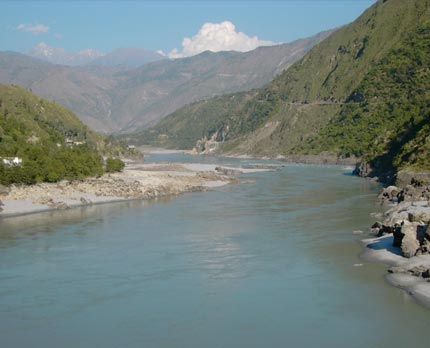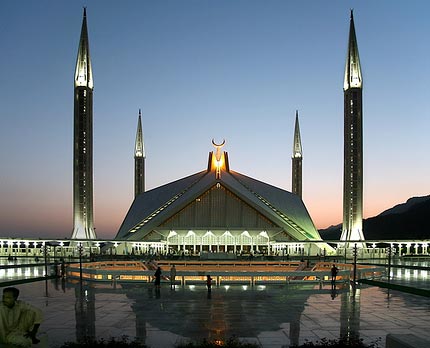Pakistan
Country statistics

Land area: 300,664 sq miles (778,720 sq km)
Total area: 310,401 sq miles (803,940 sq km)
Population (2010 est.): 177,276,594 (growth rate: 1.5%); birth rate: 25.0/1000; infant mortality rate: 65.3/1000; life expectancy: 65.3; density per sq miles: 215
Capital City: Islamabad
Monetary unit: Pakistan rupee
Languages: Urdu 8%, English (both official); Punjabi 48%, Sindhi 12%, Siraiki (a Punjabi variant) 10%, Pashtu 8%, Balochi 3%, Hindko 2%, Brahui 1%, Burushaski, and others 8%
Ethnicity/race: Punjabi, Sindhi, Pashtun (Pathan), Baloch, Muhajir (immigrants from India and their descendants)
Religions: Islam 97% (Sunni 77%, Shiite 20%); Christian, Hindu, and other 3%
Country introduction

Located in the north-western part of the South Asian subcontinent, Pakistan is bordered by Iran on the west, Afghanistan on the north-west, China on the north-east, India on the east, and the Arabian Sea on the south.
There are four provinces: Sindh, Punjab, North-west Frontier Province, and Baluchistan. The federal capital is Islamabad. Pakistan occupies a strategic position between Southern Asia and the Middle East. Four mountain ranges meet within its boundaries: the Karakorams, the Pamirs, the Himalayas, and the Hindu Kush.
The land is very varied, including deserts, mountain, forests, and fertile plains and is divided into three main geographic regions, the Northern high lands, Indus River Plains, and the Balochistan Plateau. The northern and western highlands of Pakistan contain the towering Karakoram and Pamir mountain ranges, which include some of the world's highest peaks: K2 (8,611 m / 28,250 ft) and Nanga Parbat (8,126 m / 26,660 ft). An expanse of alluvial plains, the Punjab and Sind, lie to the east. The 1,000 mile long (1,609 km) Indus River and its tributaries flow through the country from the Kashmir region to the Arabian Sea. The Baluchistan Plateau lies to the west and the Thar desert lies in the east.
The culture

In antique times, Pakistan was a major cultural center. Many cultural practices and great monuments have been inherited from the time of the ancient rulers of the region. One of the greatest cultural influences was that of the Persian Empire, of which Pakistan was a part. In fact, the Pakistani satraps were at one time the richest and most productive of the massive Persian Empire. Other key influences include the Afghan Empire, Mughal Empire and later, the short lived but influential, the British Empire.
Pakistan has a cultural and ethnic background going back to the Indus Valley Civilization, which existed from 2800 - 1800 BC, and was remarkable for its ordered cities, advanced sanitation, excellent roads, and uniquely structured society. Pakistan has been invaded many times in the past, and has been occupied and settled by many different peoples, each of whom have left their imprint on the current inhabitants of the country. Some of the largest groups were the 'Aryans', Greeks, Scythians, Persians, White Huns, Arabs, Turks, Mongols, Afghans, Buddhists and other Eurasian groups, up to and including the British, who left in the late 1940s.
Today the society of Pakistan consists of assorted cultures and national groups, which include the Punjabis, Kashmiri and Sindhis in the east; the tribal cultures of the Baloch and Pashtun in the west; and the very old Dardic and Tajik communities in the north. These Pakistani cultures have been greatly influenced by many of the surrounding countries' cultures, such as the Turkish, Persian, Afghan, and Indians of South Asia, Central Asia and the Middle East.
Pakistani culture can be called as "Mixed Culture". Although the majority of people in Pakistan are Muslims by birth and faith, there is a strong influence of Hindu culture on the present Pakistani culture. The shadows of this influence are quite visible on the marriage ceremonies and festivals like "Basant".
Dowry Systems and heavy expenditures on the marriage of girls is done, which is inherited from Hindu society because in Hindu society there is no share of women in the inheritance of their parents. Although women are given a share in the inheritance of their parents in Pakistani society, there are huge expenditures on the marriages of daughters.
Pakistani society is a "Male Oriented Society", where they are given full protection and great respect. The family is headed by a male member, usually the oldest male member of the group. He guides the other members. Old people are given positions of prestige, honor and respect in Pakistani culture.
Dress in a Muslim society like Pakistan is designed and intended to cover human body, as nudity is prohibited in Islam. So, people of Pakistan prefer to wear simple dresses according to their climate.
Pakistani handicrafts are gaining popularity in the world market day by day, as Pakistani craftsman are considered as the best in their craftsmanship. Pakistan is famous for its high standard items of glass, silver, wooden furniture, pottery, marble goods and things made of camel skin.
Cricket, Hockey, Football, Kabbadi, squash, badminton, and wrestling are the major sports in Pakistan. Ulema, Mushaikh and Sufi poets occupy highly honored places in Pakistani culture.
Attractions & landmarks

Pakistan boasts three internationally significant cities. The political capital is Islamabad in the north. Traditionally, this has been a quiet city, with most of its residents being employees of the federal government and most of its notable buildings political or legal seats. The city contains several attractive parks and gardens, and is relatively spacious and peaceful in comparison to other Central Asian metropolises. The Rose and Jasmine Garden is an expansive, aromatic area containing over 250 species of roses. Flower shows are occasionally held here and there is an adjoining campsite. One of Pakistan's most recognisable landmarks, the Faisal Masjid Mosque is a stunning building, gifted to Islamabad by King Faisal of Saudi Arabia. Although a visit is definitely worthwhile, visitors should dress and act respectfully at all times, something that should be done at all times whenever visiting a religious site.
Karachi, with a population of 18 million, is Pakistan's largest city, and is located on the Arabian Sea coast. There are plenty of wonderful historic sites Karachi, from pre-Islamic archaeology, through to fine examples of Islamic building and culture and the legacy of the British Raj. The city also has a modern cosmopolitan feel, being a popular destination with immigrants from all over Asia. The shopping and entertainment facilities are probably the best in the country. Sport fans will be kept busy by the numerous cricket clubs catering for all levels of Karachi society, or one of the several golf courses, that remain surprisingly green despite the city's scorching temperatures. Mohammad Ali Jinnah, the father of the modern state of Pakistan was born in downtown Karachi in the Wazir Mansion. The house is now a protected national monument and a site of particular significance for Pakistan's modern history.
The Punjab region's capital Lahore is Pakistan's second most populous city, with an estimated 10 million inhabitants. The city was the headquarters of the prolific Mughal Empire, and contains the Mughal Fort, a UNESCO World Heritage site and worth a visit for anybody with an interest in history or architecture. The Mughals also built The Badshahi Mosque, which claims to be the largest in the world. The Sufi gathering every Tuesday evening gives a real insight to an area of Pakistani culture. Visitors are welcomed to the Shah Jamal Shrine, and seated in an area separate to Muslims as the famous drummer Pappoo Saein performs, supported by dancing devotees of the saint.
The Indus Valley is one of the most archaeologically significant sites in the world and contains one of the earliest examples of human civilization. The settlement flourished between 2600 - 1900 BC, and the site at Harappa, discovered in 1922, contains a temple, palace and granary. It is still under excavation today.
Visitors near the mountainous region of Nagar during September are recommended to visit the Silk Route Festival. This is a fascinating celebration of the distinctive culture of Pakistan's mountain people, where visitors can watch artisans plying their trade in beautiful pavilions, creating local arts and crafts and weaving cloth. Visitors can also watch the ethnic fashion festival and purchase some clothes. Open-air stages host performers of folk song and dance from all over the region. There are many stalls containing home made foodstuffs. This festival is a rare chance to gain real insight into the unique culture of Pakistan's mountainous regions.
The Shandur Polo Competition takes place in Northern Pakistan every July. Teams from local areas compete in the ancient sport, which traces its roots back to Central Asia in 600 BC. Back then, polo matches served as training for cavalry units, and teams could have up to 100 players on each side. Now the teams have 6 players per side and the atmosphere is a little less intimidating, although players and locals retain a fierce passion for the sport. The celebration at Shandur was first organised by the British Major Cobb in 1936, who was a polo enthusiast himself, and wanted an organised tournament in which local teams could compete. The tournament is at least as popular today as it was then, and to be amongst the fans who in some cases travel many miles through the mountains to support their team would be unforgettable for a traveller looking for an authentic experience of Northern Pakistani culture.